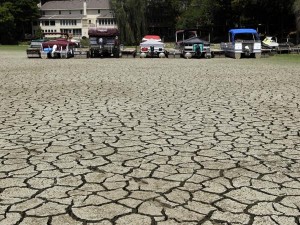After heavy rains and floods, dry spell plagues Mindanao
DAVAO CITY, Philippines—The current dry spell, which has pushed water tables deeper underground and is drying up lakes, is not just causing hydropower plants to generate less electricity but is also threatening Mindanao’s food production.
The worsening weather condition has prompted officials to ask farmers to prepare for the worst by planting drought-resistant root crops, and the public to conserve water in their households.
Armando Ansingco, chair of the Southern Mindanao Regional Agriculture and Fishery Council (RAFC), said crop yields this year are estimated to decrease by 20 percent in the region compared to last year, as the absence of rain has already affected some areas.
He said some farms in well-irrigated areas might barely feel the effects of the dry spell but “rainfed areas will suffer if the dry spell continues.”
Remelyn Recoter, regional director of the Department of Agriculture in Southern Mindanao, said 80 percent of the 53,000 hectares of riceland in Southern Mindanao is irrigated, although irrigation canals have dried up in some places.
Article continues after this advertisementBut even if only the 20 percent that depends on rain is affected by the dry spell, that would still have a considerable impact on food production.
Article continues after this advertisementAnsingco said the best way to mitigate the effects of the drought is for farmers to quickly switch to drought-resistant root crops.
“Let us brace for the worst and prepare ourselves,” he said, “We can do it because we’ve been here before.”
Recoter said agriculture officials have considered cloud seeding in some areas, but this has to be thoroughly studied because it can cause damage to crops vulnerable to too much rain such as bananas.
“We have to evaluate thoroughly if we consider that option because some crops like watermelon and banana, which thrive well in summer, would not benefit, and might even be destroyed, by cloud seeding,” she said.
Southern Mindanao produces more bananas than rice. It contributes only 2 to 2.5 percent of the country’s rice production, Recoter said.
In the case of the rice-producing town of Magsaysay in Davao del Sur, officials said the low water level in irrigation systems there had delayed the planting season. It should have started during the first week of this month.
Exequiel Elentorio, president of the Badagoy Irrigators Association, said at least 40 percent of their 1,680 members have not planted yet as irrigation ditches have dried up due to the dry spell.
For the remaining 60 percent, whose farms are located near irrigation systems still with water, Elentorio said they have had to ration water to be able to plant.
The experience of Magsaysay farmers was also being experienced by their counterparts in Maguindanao.
Mosa Saligan, a farmer in Datu Odin Sinsuat, Maguindanao, said they could not replant for lack of rain.
”There are some areas which are irrigated but most in the upland are without irrigation. We rely on rains that we have not experienced for a long time,” said another farmer, Kali Usman of Upi, Maguindanao.
Makmod Mending, ARMM regional secretary of the agriculture and fishery, said his office has sent teams to monitor the condition of farms in Maguindanao so appropriate action could be taken.
He said cloud seeding was one of the options being considered.
Sources at the National Power Corp. said the cloud seeding was also being considered to induce rains and boost the water level at Lake Lanao and at Pulangi River.
These two water systems run hydropower plants that generate about 60 percent of Mindanao’s power needs.
The lack of water at the Pulangi Hydro Electric Power Plant in Bukidnon reduced the plant’s capacity by 60 megawatts, according to Rudy Brioso, vice president for Mindanao generation of the Napocor.
Brioso said the same thing was happening at the Agus power plants in Lanao, which draw water from Lake Lanao.
He said the water elevation at Lake Lanao was still above the critical level of 698.15 meters.
“The hydropower plants (in Lake Lanao) can still operate at as low as 699.15 meters but if (water level) goes down beyond that, we will be forced to shut down the plants,” he said.
Brioso admitted that if hydropower plants shut down due to the lack of water, the power crisis that has been affecting Mindanao since February could worsen.
Already, many areas suffer from up to six hours of power outages each day.
In Cagayan de Oro City, an official of the Cagayan de Oro Electric Power and Light Company (Cepalco), said they were at the mercy of the generating companies.
Cagayan de Oro needs 140 megawatts of power but the actual supply now is just 39 megawatts, according to Marilyn Echavez, Cepalco’s community relations manager.
Efren Uy, president of the Cagayan de Oro Chamber of Commerce and Industry (CDOCCI), said the power outages have been causing heavy losses.
“Our conservative estimate is that for 300-350 megawatts of power deficiency, we lose P30 million per hour,” Uy told the Inquirer in a telephone interview. He said the estimate includes expenses on power generators that businesses have had to install at their establishments.
RELATED STORIES
EPIRA is to blame for Mindanao power crisis, says group
